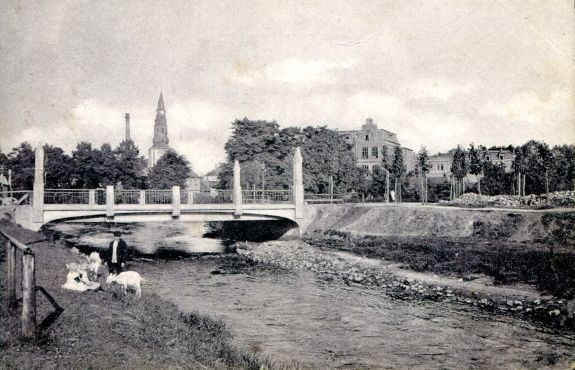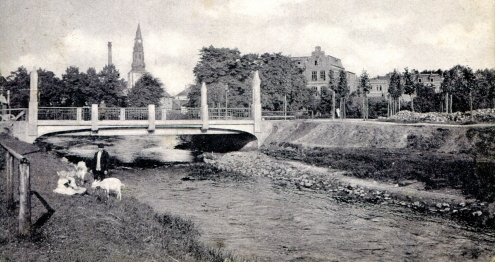Photo of the month - August 2023
The bridge construction at the Ravarditor
In the city council meeting of 11 May 1909, Mayor Clemens Wesemann presented a development plan concerning the as yet undeveloped area between Hohenzollernstraße and Westend. In particular, this concerned the construction of a new road - today's Meckenemstraße - and the building of a bridge with an 18-metre span over the Aa at the Ravarditor.
The connection of the western and southern parts of the city by a bridge had become necessary to relieve the Ravardistraße. Previously, all passenger and vehicle traffic coming from the west was routed through the city to the railway station via this traffic route.
The city had the construction work officially put out to tender as early as January 1910, even though the bridge construction had not yet been discussed at all in a public council meeting. In a presentation on 7 June 1910, Hermann Kraatz, the city's building officer, finally presented the bridge construction project he had conceived to the city councillors. According to this, the river crossing was also to be used by the Bocholt-Aalten light railway.
Construction and design cost 30,900 Marks
The company "Beton- und Eisenbetonbau Union" from Hanover took over the construction, whereby the construction costs including those for the artistic design amounted to a total of 30,900 Marks. Construction work began on 12 August 1910. In the spring of 1911, the bridge was completed to such an extent that the test load with weights totalling 72.5 tons could be carried out.
On 7 March, iron girders and sand weighing more than 50 tons were placed in the middle of the bridge and another 20 tons at the ends and on the troughs. This corresponded to a load of about 500 kilograms per square metre. The result was satisfactory, as the load on the bridge led to a deflection of only 1.5 millimetres. Before the bridge was released, the sculptor Schröder from the company Heid & Münckeberg from Hanover designed the concrete pillars and obelisks with artistic ornaments. Among other things, the pillars were decorated with the Bocholt city coat of arms.
The photo shows a view of the Aa Bridge from the west shortly after its completion. Passers-by are walking their pets along the unpaved riverbank. The tower of St. George's Church can be seen in the background and the Marienlyzeum behind the trees. The bridge was not damaged during the last world war. However, it was fundamentally renewed and widened in the spring of 1962.




